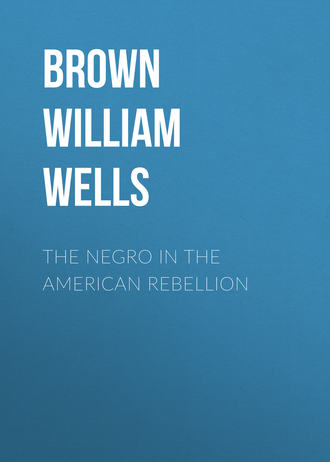 полная версия
полная версияThe Negro in The American Rebellion
A few hours after entering the rebel works, our soldiers were gladdened by a sight of the veterans of the Army of the Potomac, who that night relieved our men at the front. A glance at the strong works gave the new-comers a better opinion of the fighting qualities of the negroes than they had calculated upon; and a good feeling was at once established, that rapidly dispelled most of the prejudices then existing against the blacks; and from that time to the close of the war the negro soldier stood high with the white troops.
After spending some time at the Bermuda Hundreds, the Sixth Regiment was ordered to Dutch Gap, Va., where, on the 16th of August, they assisted in driving the rebels from Signal Hill; Gen. Butler, in person, leading our troops. The Sixth Regiment contributed its share towards completing Butler’s famous canal, during which time they were often very much annoyed by the rebel shells thrown amongst them. The conduct of the men throughout these trying scenes reflected great credit upon them. On the 29th of September, the regiment occupied the advance in the demonstration made by Butler that day upon Richmond. The first line of battle was formed by the Fourth and Sixth Regiments: the latter entered the fight with three hundred and fifteen men, including nineteen officers.
The enemy were driven back from within two miles of Deep Bottom, to their works at New-Market Heights: the Sixth was compelled to cross a small creek, and then an open field. They were met by a fearful fire from the rebel works, men fell by scores: still the regiment went forward. The color-bearers, one after another, were killed or wounded, until the entire color-guard were swept from the field. Two hundred and nine men, and fourteen officers, were killed and wounded. Few fields of battle showed greater slaughter than this; and in no conflict did both officers and men prove themselves more brave. Capts. York and Sheldon and Lieut. Meyer were killed close to the rebel works. Leuts. Pratt, Landon, and McEvoy subsequently died of the wounds received. Lieut. Charles Fields, Company A, was killed on the skirmish line: this left the company in charge of the first sergeant, Richard Carter, of Philadelphia, who kept it in its advanced position throughout the day, commanding with courage and great ability, attracting marked attention for his officer-like bearing. During the battle many instances of unsurpassed bravery were shown by the common soldier, which proved that these heroic men were fighting for the freedom of their race, and the restoration of a Union that should protect man in his liberty without regard to color. No regiment did more towards extinguishing prejudice against the negro than the patriotic Sixth.
“And thus are Afric’s injured sonsThe oppressor’s scorn abating,And to the world’s admiring gazeTheir manhood vindicating.”The writer regrets that he cannot remember all those whose good conduct in this our last battle deserves honorable mention. It may not, however, be invidious to mention the names remembered. These are, Sergt. – Major Hawkins, Sergt. Jackson, Company B (since deceased); Sergts. Ellesberry, Kelley, Terry, and Carter All of these, as well as a number of others, were capable of filling positions as commissioned officers.
Several of the enlisted men received medals for gallantry, and were mentioned in General Orders by Major-Gen. Butler. The works which the Sixth Regiment attempted to take at such fearful cost of life were in a short time taken at the point of the bayonet by another brigade of colored troops. Had these latter been present to aid in the first attack, it would have saved many valuable lives; for the force was entirely too weak for the object. When the Sixth Regiment was finally paid off at Philadelphia, at the close of the Rebellion, the officers held a farewell meeting at the Continental Hotel; and the following resolutions were adopted as expressive of their appreciation of the conduct of the troops under their command: —
“1. Resolved, That, in our intercourse with them during the past two years, they have shown themselves to be brave, reliable, and efficient as soldiers; patient to endure, and prompt to execute.
“2. That, being satisfied with their conduct in the high position of soldiers of the United States, we see no reason why they should not be fully recognized as equals, honorable and responsible citizens of the same.”
From the commencement of the enlistment of colored troops, to the close of the war, there were engaged in active service one hundred and sixty-nine-thousand six hundred and twenty-four colored men.


